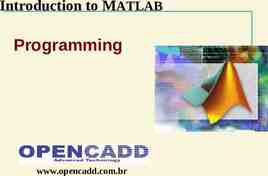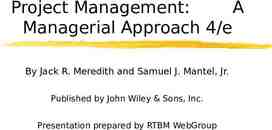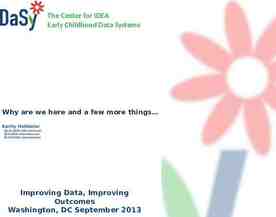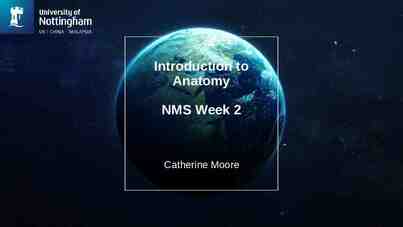CS 160: Lecture 2 Professor John Canny Fall 2004 05/10/24 1
56 Slides2.14 MB

CS 160: Lecture 2 Professor John Canny Fall 2004 05/10/24 1

History of HCI Personalities: * Vannevar Bush - Universal information access * J.C.R. Licklider - Networking, Agents * Ivan Sutherland - Sketchpad * Doug Engelbart - Mouse, GUI, Word proc. * Ted Nelson - Hypertext * Alan Kay - OO programming, Laptops * Don Norman - Cognitive principles * Jacob Nielsen - Usability 05/10/24 2

History of HCI Systems: * Memex - 1945 (concept) * Sketchpad - 1963 * NLS (oNLine System) - 1963-68 (mouse ‘64) * Xerox Alto ‘72, Star ‘81 * Grid Compass 1983 * Apple Lisa ‘83, Mac ‘84, NeXT ‘88 * Powerbook 1991 * HTML, HTTP 1994 05/10/24 1968 Dynabook 1983 3

History of HCI Politics * Military Funding NDRC - OSRD - ARPA – DARPA * Elite universities (MIT, Stanford, CMU, Berkeley) * NSF 1950 present * Xerox PARC - 1970 present * Apple - NeXT * Hypertext 1967. Prototypes: HES 1969, ZOG 1975. Xanadu 1981, not funded ‘til 87 (Hypercard 1987) 1989 Xanadu - Autodesk, WWW proposal 05/10/24 4

Online History There was an excellent PBS special on the history of computing that covered most of these topics: http://www.pbs.org/opb/nerds2.0.1/ 05/10/24 5

People Vannevar Bush (1890-1974) * Engineer by training (MIT) * Differential analyzer - 1930 * Led computing research in ‘30s * Created military research NDRC ‘40, OSRD ‘41-47 * Managed nuclear weapons research throughout the 40’s * Wrote “science - the endless frontier” 1945 * Military consultant through 50’s 05/10/24 6

Memex Its 1945, what should the ultimate computer look like? What should it do? 05/10/24 7

People Bush’s “as we may think” 1945 * Proposed the “Memex” a very modern computer 05/10/24 8

Bush’s Memex Individuals store all personal books, records, communications Items retrieved rapidly through indexing, keywords, cross references,. Can annotate text with margin notes, comments. Can construct a trail through the material and save it Acts as an external memory 05/10/24 9

Post-Memex After WWII, Bush continued to push for analogue computers (and against digital). Which just goes to show that people with great ideas don’t get it right all the time 05/10/24 10

J.C.R. Licklider 1915-1990 Ph.D. 1942 Rochester, Psychologist Started “Human Engineering group” at MIT’s Lincoln labs in 1951 Tried to evolve psych. into a department within MIT’s Electrical Engineering ARPA created in 1958 in response to Sputnik, “Lick” became director of CS research in 1962. With ARPA sponsorship, the first CS programs were created: * MIT, CMU, Berkeley, Stanford 05/10/24 11

J.C.R. Licklider 1915-1990 At ARPA, Licklider promoted computing research and sponsored: * Time-sharing * Networking * Engelbart’s and Sutherland’s online computing work Why was this controversial at the time? 05/10/24 12

J.C.R. Licklider publications Man-computer symbiosis – 1960 Libraries of the future – 1965 The computer as communication device - 1968 05/10/24 13

Man-Computer Symbiosis - 1960 Did self-observation of his daily work. * Observed that much work was mundane and related to accessing and organizing information Proposed: * Digital libraries * Display screens with pen input and character recognition * Wall displays for collaborative work * Speech recognition and production for HCI 05/10/24 14

The Computer as a Communication Device - 1968 Cooperative work with shared and individual screens Pen chat Online communities Agents – OLIVERs On-Line Vicarious Expediter and Responder 05/10/24 15

Networks, Time-sharing Much of Licklider’s sponsored research was unpopular in the engineering community: “Time-sharing is a waste of valuable computer time” “Why are we doing this?” * BBN engineer about the first computer network 05/10/24 16

Ivan Sutherland 1938 MIT Ph.D. in 1963 Ph.D. work was “Sketchpad” Pioneered computer graphics and CAD Started Evans and Sutherland in 1968 05/10/24 17

Ivan Sutherland 1938 Sketchpad was a very modern pen-based interactive system that support CAD design and 3D modeling. Its novelty was its interactivity (real-time computing was practically non-existent). 05/10/24 18

Doug Engelbart 1925 Ph.D. UC Berkeley (EE) in 1955 Thesis on “plasma digital devices” - a way into computing Strongly influenced by Bush’s article Moved to SRI, started formulating human augmentation ideas in 1959 Funding from ARPA in 1963 NLS (oNLine System) demo 1968 05/10/24 19

Doug Engelbart How would you implement Bush’s Memex in 1963? 05/10/24 20

Engelbart’s innovations NLS (1968) featured: * * * * * * * * Video screen and keyboard Mouse and chordal keyboard Videoconferencing Hypertext linking Word processing E-mail A window system User testing! 05/10/24 21

Engelbart’s work Continued at SRI, worked on network extensions Funding dwindles through the 70’s , AI HCI NLS project sold in 1977 to Tymshare * Half of the ( 40) NLS engineers moved to Xerox PARC, others to Tymshare * Engelbart fired from SRI in ’77, moves to Tymshare Migrated to McDonnell-Douglas in 1984, until 1989 pushed for open hypertext systems Started Bootstrap institute in 1989 05/10/24 22

Engelbart’s work 80s and 90s: Personal computing and the web happen Engelbart Receives the ACMTuring award in 1997 “For an inspiring vision of the future of interactive computing and the invention of key technologies to help realize this vision” 05/10/24 23

Ted Nelson 1937 M.A. Sociology, Harvard ’63 Coined “hypertext” in 1960 Worked with Van Dam at Brown on HES – 1967 Designed Xanadu in 1981 * Global hypertext * Pay-per-view * Not funded until 1987 Hypertext as a more natural medium than linear text for creative writing “I build paradigms. I work on complex ideas and make up words for them. It is the only way.” 05/10/24 24

Tim Berners-Lee/ Mark Andreessen Berners-Lee Co-developed the HTTP/HTML standard as an open standard (1991). Key facilitator was an active user group (Physicists) who needed hypertext. Mark Andreessen added the “Mosiac” browser which simplified access and opened up the “web” to anyone (1993). 05/10/24 25

Alan Kay 1940 Ph.D. 1969 (Utah) Computer Graphics In 1968, met Seymour Papert (LOGO) in the MIT AI Lab. - kids can program! Moved to Xerox PARC in 1972 Started developing “Smalltalk”, in the Learning Research Group First general OO programming language Influenced by Simula * Engineers can program! 05/10/24 26

Alan Kay @ PARC Dynabook (first personal computer) conceived by Kay in 1968. What should it look like? 05/10/24 27

Alan Kay @ PARC Dynabook (laptop computer) conceived in 1968, well ahead of its time. As interim steps, Kay pushes the Xerox Alto (1972) and Star, the first real personal computers. Xerox Alto 05/10/24 28

Alan Kay @ PARC The Star (1981 and begun in 1975) in particular was a very advanced machine. It had most of the “WIMP” elements we know today. The Star was the result of extensive user testing, and its design has stood the test of time (Liddle article). Many design features were better than its successors (e.g. object-oriented editing features) 05/10/24 29

The Star group The Star design team developed a new methodology for system design: Task analysis Wide range of users Usage scenarios Decomposition of design: * display and control interface * User’s conceptual model Many prototyping cycles Desktop metaphor, direct manipulation, WYSIWYG 05/10/24 30

Star - Mac But the Star was expensive and slow ( 25k). Steve Jobs and Apple engineers visited PARC in 1979, and that set the path for Apple 15 PARC engineers migrated to Apple Apple Lisa ships in 1983 at 10,000, and fails in the marketplace The Apple Macintosh ships in 1984 at 2500, and the personal computing market changes for good 05/10/24 31

Alan Kay after PARC Kay worked briefly at Atari, then became an Apple fellow in 1984. Often visited the MIT Media Lab in the 80’s and 90’s. In 1996 he left for Disney to become a Disney fellow. Left Disney because of cutbacks, joined HP labs in 2002. 05/10/24 32

Alan Kay quote "Don't worry about what anybody else is going to do The best way to predict the future is to invent it. Really smart people with reasonable funding can do just about anything that doesn't violate too many of Newton's Laws!" 05/10/24 33

Small Devices The Apple Newton was the first “PDA” (1993) but didn’t succeed commercially. Still popular, though out of production. Has achieved a kind of cult status. 05/10/24 34

Palm Pilot Jeff Hawkins was an EE with an interest in cognitive science and the brain. Worked at GRiD. Wrote Ph.D. proposal at Berkeley in Biophysics in 1987 - rejected. Back to GRiDPad - first pen computer? Developed a handwriting recognizer based on his interests in the Brain. 05/10/24 35

Palm Pilot Next try “Zoomer” 1993 - a failure commercially Intensive studies of Zoomer users began in 1994. Decided the PDA should be a paper replacement, not a PC replacement. Switched to graffiti. Shrunk to pocket size. Unveiled the Palm Pilot in 1994. 05/10/24 36

Tablet PC Excellent writing surface, pen, digital ink. Compromise on: * Keyboard * Weight * Battery life Still trying to be a PC. Many formats, will natural selection choose a winner? - or is it headed the way of the Newton? 05/10/24 37

Smart phones Qualcomm’s PDQ 1999 (Jacobs) - phone with a complete Palm Pilot inside. Other models followed. Latest generation of phones support “applets”. Motorola J2ME phones. Qualcomm’s BREW (binary) environment. GPS will enable locationbased services. 05/10/24 38

Phono-photo-orga-loca-lizers Butler Lampson (Time-sharing, Dynabook, Alto, Turing award) argues that when devices are “close enough” (e.g. factor of two) in size and cost, they collapse. So, cell phones, PDAs, cameras, GPS’s will merge into one product. 05/10/24 39

Break 05/10/24 40

Admin issues First assignment is due next Wednesday in class If you’re ready you can hand it in at end of today. http://www.cs.berkeley.edu/ jfc/cs160/F04 - notes, handouts are there under “lectures” Class account forms will be handed out next week Section times – 9,10 am Tuesday – poll Lab times - poll Ombudsperson – volunteer? 05/10/24 41

HCI principles Wilfred Hansen (1971) introduced principles for UI design: “Know the user” “Minimize Memorization” “Optimize Operations” “Engineer for Errors” 05/10/24 42

HCI principles “The Psychology of Human-Computer Interaction” by Card, Moran and Newell, 1983 Included mechanistic models of human behavior, the MHP or “Model Human Processor”. 05/10/24 43

HCI principles Don Norman introduced many principles from cognitive science: (1980s – 90s) Mental representation. Gibson’s affordances. Direct Manipulation (WYSIWYG). Human-centered design. 05/10/24 44

HCI principles John Gould (1988) in “How to Design Usable Systems” outlined many modern principles of UI design: Early, continuous, focus on users Early and continuous user testing Iterative Design Integrated Design Suggested observation of users in their workplace, “thinking aloud”, videotaping, task analysis, discovery of work context, 05/10/24 45

HCI principles Jacob Nielsen fostered a science of “Usability” in the 1990s. Structured processes for evaluation and development of UIs and web sites. Pioneered “heuristic evaluation” and other low-cost usability methods. Emphasized the economic benefit of usability improvement to companies. 05/10/24 46

Contextual Inquiry Main advocates: Hugh Beyer and Karen Holtzblatt Contextual Design book published in 1997 Structured interview process and thinking aloud. Almost universal now in user interface design. 05/10/24 47

What hasn’t happened (yet) Virtual Reality: create a world in the computer that’s like the “real world”: Microsoft “BOB”. 05/10/24 48

What hasn’t happened (yet) VR still has potential, but it must be applied carefully. Keep in mind that: People adapt their real-world skills quite well to non-physical environments: navigation on the web. Much of the detail in the physical world is irrelevant to the task. In the real world, we rely a great deal on text and documents. Existing 2D interfaces are optimized to the kinds of information access that we need to do. 05/10/24 49

What hasn’t happened (yet) Speech interfaces haven’t “taken over” UI design. There are growing applications of speech interfaces (especially telephone systems). But speech-only is very cumbersome, you can’t scan, search visually, select or use graphicsimagine finding an Amazon book with speech only! In real life, we still prefer text and graphics to communicate complex ideas. Speech requires shared understanding and “everyday” knowledge that is hard for computers. 05/10/24 50

What hasn’t happened (yet) Today, most HCI researchers believe speech will be used in combination with other I/O modes whenever possible. This is the area of “Multimodal” UIs. 05/10/24 51

What hasn’t happened (yet) Intelligent “agents” that you interact with like a person. There are some examples and this is still a research area, but it has been found that: Some benefits of agent interaction apply in much simpler cases: people are “influenced by” and make human-like attributions to text interfaces. Agents can “get in the way” of the user and their task – the opposite of direct manipulation. Successful agents are complex and expensive to build – no profit for the company. 05/10/24 52

What hasn’t happened (yet) On the other hand, agents have great potential for entertainment. Many successful games use agents, e.g. The Sims Toys are appearing with agent-like behavior (Sony’s Aibo). This creates powerful infrastructure for agent design, which may yield results for HCI. 05/10/24 53

The future? Smart rooms, cars & homes Wearable computers Multimodal and tangible UIs Context-aware and “anywhere” interfaces 05/10/24 54

Summary Many seminal ideas came from the very early years of computing Considering the user (even if its yourself) leads to new ideas Innovation happened in bursts, depending on funding and the right environment A modern design process led to a very modern design (the Xerox Star) 05/10/24 55

Summary (contd) The theoretical influences in HCI have not been obvious (a little cognitive science and AI, quite a lot of anthropology and social psychology). User-centered design and iteration evolved by trail-and-error. Some appealing kinds of interaction haven’t taken over (VR, speech, agents) – beware naïve models of human behavior. 05/10/24 56






